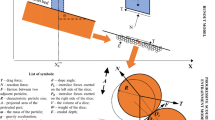Abstract
The Niumiangou Creek rock avalanche was triggered by an Ms 8.0 earthquake that happened on 12 May 2008 in the Sichuan Province, China. The rock avalanche traveled a horizontal distance of 3.0 km over a vertical elevation difference of 0.89 km, equivalent to a coefficient of friction of only 0.29. The travel path of the rock avalanche can be divided into three segments: (1) failing and disintegrating, (2) flying, (3) flowing. In the failing and disintegrating segment, the rock slope failed because of the coupled action of horizontal and vertical force of the earthquake, then smashed into the opposite mountain and disintegrated. In the flying segment, the disintegrating rock mass changed direction and flew into the Lianhuaxin Creek, which was different from the previous research results that concluded rock debris flowed in Lianhuaxin Creek. A great amount of air trapped and compressed under the rock debris acted as air cushion and supported the rock debris to fly a further distance. In the flowing segment, the rock debris flowed on the ground surface in Niumiangou Creek. The flowing velocity has been estimated from the maximum elevation and runup according to the damaged trimlines of the debris. The saturated fine material in Niumiangou Creek entrained by the failed debris mass is thought to have contributed to the long runout of the debris. The Niumiangou Creek rock avalanche is one of the three longest rock avalanches triggered by Wenchuan earthquake. The conclusions of the paper have implications for hazard assessment of potential rock avalanches in the earthquake area and the other similar mountainous area in west China.


















Similar content being viewed by others
References
Abele G (1974) Bergsturze in den Alpen: Munich. Wiss Alpenvereinshefte 25:230
Abele G (1997) Rockslide movement supported by the mobilization of groundwater-saturated valley floor sediments. Zeischrift Geomorphol 41:1–20
Bagnold RA (1968) Deposition in the process of hydraulic transport. Sedimentolgy 10:45–56
Bagnold RA (1973) The nature of saltation and of bed-load transport in water. Proc R Soc London Ser A 332:473–504
Buss E, Heim A (1881) Der Bergsturz von Elm. Zurich, Worster, 133
Cruden DM, Hungr O (1986) Structures in the debris of the Frank Slide. Can J Earth Sci 23:425–432
Davies TR, Mcsaveney MJ, Hodgson KA (1999) A fragmentation-spreading model for long-runout rock avalanches. Can Geotech J 36(6):1096–1110
Erismann TH, Abele G (2001) Dynamics of rockslides and rockfalls. Springer, Berlin, Heidelberg, Germany, pp 243–246
Evans SG, Clague JJ, Woodsworth GJ (1989) The Pandemonium Creek rock avalanche, British Columbia. Can Geotech J 26:427–446
Evans SG, Hungr O, Clague JJ (2001) Dynamics of the 1984 rock avalanche and associated distal debris flow on Mount Cayley, British Columbia, Canada; implication for landslide hazard assessment on dissected volcanoes. Eng Geol 61:29–51
Hewitt K (1988) Catastrophic landslide deposits in the Karakoram Himalaya. Science 242:64–67
Hsu KJ (1975) Catastrophic debris streams (sturzstroms) generated by rockfalls. Geol Soc Am Bull 86:129–140
Hungr O, Morgenstern NR (1984) Experiments on the flow behaviour of granular materials at high velocity in an open channel. Geotechnique 34(3):405–413
Kong JM, Cui Y, Tian SJ, He FY (2009) Typical case study on the development characteristics of fragmentation-sliding seismic landslide. J Sichuan Univ (Eng Sci Ed) 41(3):119–124
McDougall S, Boultbee N, Hungr O, Stead D, Schwab JW (2006) The Zymoetz River landslide, British Columbia, Canada: description and dynamic analysis of a rock slide-debris flow. Landslides 3:195–204
Sassa K (1988) Geotechnical model for the motion of landslides. In Bonnard C (ed) Landslides. Proceedings, 5th International Symposium on Landslides, 1: 37–56
Strom AL (2006) Morphology and internal structure of rockslides and rock avalanches: grounds and constraints for their modeling. In: Evans SG, Scarascia Mugnozza G, Strom A, Hermanns RL (eds) Landslides from Massive Rock Slope Failure. NATO Science Series: IV: Earth and Environmental Sciences, Springer, Berlin. 49, pp 305-328
Voight B, Sousa J (1994) Lessons from Ontake-san: a comparative analysis of debris avalanche dynamics. Eng Geol 38:261–297
Wang ZF (2008) A preliminary report on the Great Wenchuan Earthquake. Earthquake Eng Eng Vibration 7(2):225–234
Wu SR, Wang T, Shi L, Sun P, Shi JS, Li B, Xin P, Wang HB (2010) Study on catastrophic landslides triggered by 2008 great Wenchuan earthquake, Sichuan, China. J Eng Geol 18(2):145–159
Xu Q, Huang R (2008) Kinetics characteristics of large landslides triggered by May 12th Wenchuan earthquake. J Eng Geol 16(6):721–729
Yin Y, Wang F, Sun P (2009) Landslide hazards triggered by the 2008 Wenchuan earthquake, Sichuan, China. Landslides 6:139–151
Acknowledgments
This work was supported by the Basic Science Foundation of the Institute of Geomechanics, Chinese Academy of Geological Sciences (Grant No. DZLXJK201011), the China Postdoctoral Science Foundation (Grant No. 20100470393), and the China Geological Survey Foundation (Grant No. 1212011014032).
Author information
Authors and Affiliations
Corresponding author
Rights and permissions
About this article
Cite this article
Zhang, M., Yin, Y., Wu, S. et al. Dynamics of the Niumiangou Creek rock avalanche triggered by 2008 Ms 8.0 Wenchuan earthquake, Sichuan, China. Landslides 8, 363–371 (2011). https://doi.org/10.1007/s10346-011-0265-9
Received:
Accepted:
Published:
Issue Date:
DOI: https://doi.org/10.1007/s10346-011-0265-9




